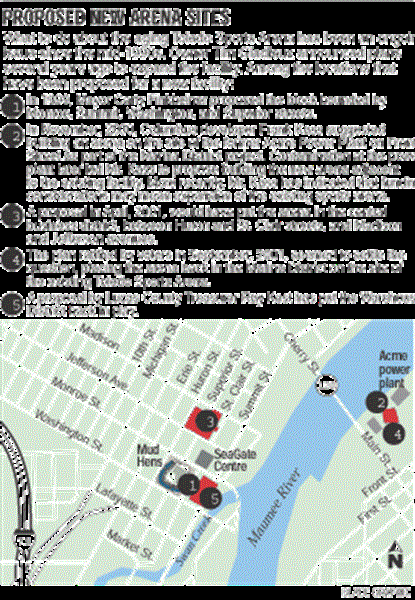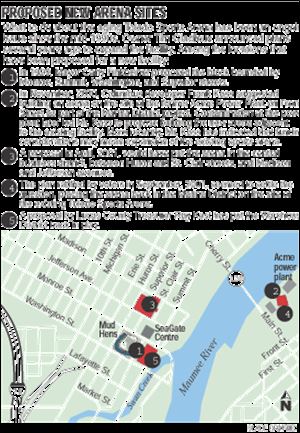
Kest's arena plan under city review
7/2/2003
In what is shaping up as a battle of East vs. West, or Ford vs. Kest, Lucas County Treasurer Ray Kest pressed forward yesterday with his proposal for a downtown sports arena in the Warehouse District.
Mr. Kest, who said he developed the plan on his own and as part of a PhD course at Cleveland State University, met with the executive board of Downtown Toledo, Inc., a merchants' association.
“Overall I thought it went very well,” said James Murray, chairman of the DTI board. “A lot of things in there made some sense.”
Mr. Murray said some of the numbers, such as events per year and the potential income, have to be reviewed. He said the association voted previously to endorse a new arena as part of the proposed Marina District in East Toledo but added that was because it was the only plan on the table.

“Now Ray's got one out there and he's asking people to get on board with that,” Mr. Murray said.
Mr. Kest's proposal is for Lucas County to take the lead on building an arena and for his office to buy most of the bonds as an investment for the county because the arena would be next to the county-owned convention center. Commissioner Harry Barlos has said the plan has merit for that reason and because it does not require a tax increase.
A 14,000-seat arena would turn a good enough profit to pay for itself, Mr. Kest contends, in the same way that Fifth Third Field is paying for itself. Mr. Kest also arranged that financing package and said low interest rates make now the time for action.
His idea of shifting the arena site back to the west side of the river was attacked by two leading City Council members.
Councilman Robert McCloskey, who represents East Toledo, said the plan would tie up downtown traffic. He suggested using Mr. Kest's financing expertise for the east-side site.
“If you had a baseball game and an event at the arena and a convention in town, where would you put all these people? We'd have to completely rebuild the downtown,” Mr. McCloskey said. “I think it's a good proposal. The Ford administration should move forward with it and build it on the east side.”
Council President Louis Escobar said the Marina District plan is moving forward at an appropriate pace.
“Why are we still bickering back and forth where the arena's going to be? I thought a decision was made. I'm supporting the arena on the [east] side,” Mr. Escobar said.
He said the city has approved an $18.5 million cleanup plan for the district, including $6 million from the state. Council last week approved a $50,000 contract with Cleveland arena consultant Tom Chema to start a national recruiting drive for a Marina District developer.
“While we do the cleanup we're spending money on Chema,” Mr. Escobar said. “The next issue is how we're going to fund [an east-side arena].”
Mayor Jack Ford said he was reviewing a copy of the Kest proposal supplied to Steven Seaton, his director of economic and community development.
“The numbers didn't quite match some of the things Tom Chema has said as far as what a 14,000-seat arena would cost. But ideas are good, so we're looking at it,” Mr. Ford said.
There has been no meeting between Mr. Ford and Mr. Kest, who were rivals for the mayor's office in 2001. Mr. Ford won the election, and Mr. Kest has denied any interest in a rematch.
Mr. Kest said he probably would not participate in financing the East Toledo site as county treasurer. He said he believes it is the wrong location because of its distance from the convention center.
“The city can do the same thing I'm doing,” Mr. Kest said. “They just haven't been innovative enough.”
In February, Mr. Ford endorsed the recommendation of Mr. Chema that the only feasible way to finance the arena was through a new tax, such as the so-called “sin tax” on cigarettes and alcohol that was used to build Jacobs Field and Gund Arena in Cleveland. Since then, however, there has been no plan announced to put such a tax on the ballot.
Under Mr. Kest's proposal, an arena could be built for $46 million in construction costs and $5 million in land acquisition and relocation costs. His plan is to finance the expense from two general sources: a surcharge on tickets averaging $2 per ticket and the annual revenues from the sale of suites, naming rights, club seats, and novelties, concessions, and rental from users, such as sports teams.
Mr. Kest said the ticket surcharge would not be a tax. He said a surcharge would range from $1 on an $8.50 hockey game ticket to $3 for a $30 ice show ticket to $4 for a $50 ticket for a “top entertainer.”
The arena would be across St. Clair Street from Fifth Third Field and across Monroe Street from the SeaGate Centre. Because of its size it could not be contained between Summit Street and St. Clair, so it would rise over Summit Street and traffic would drive under it.
The plan drew praise from Kathy Steingraber, executive director of the Toledo Warehouse District Association.
“If I were a county official, I would think it makes sense. They have that albatross at the SeaGate Centre. This alleviates that problem. It creates some synergy and makes greater use of the convention center,” Ms. Steingraber said.
“I think [Mr. Kest] is very masterful at putting these financial packages together,” Ms. Steingraber said. “He can make it work, and he did his homework.”
Gary Jacob, a property owner in the block carved out by Mr. Kest, said he'd be willing to give up his building at 23 North Summit St., even though he recently started major renovations there.
“If this is going to be a stepping stone for Toledo, I'm all for it,” he said.
Rich Poll, president of the H. Poll Electric Co. at 8 North St. Clair St., said that in the last 30 years his property has been proposed repeatedly for an arena, a ballpark, or a convention center. Under Mr. Kest's plan, Poll Electric would be relocated, but the buildings would be converted to restaurants.
“Nobody ever talks to us about it,” Mr. Poll said. “I hope they do something - across the river or here. Something happening is better than nothing.”